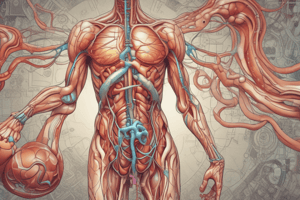Podcast
Questions and Answers
What is the primary function of the glomerulus in the nephron?
What is the primary function of the glomerulus in the nephron?
- Storage of urine
- Filtration of blood to form urine (correct)
- Secretion of hormones to regulate blood pressure
- Reabsorption of water and ions
What is the role of the proximal convoluted tubule (PCT) in the nephron?
What is the role of the proximal convoluted tubule (PCT) in the nephron?
- Secretion of hormones to regulate blood pressure
- Filtration of blood to form urine
- Reabsorption of water, ions, and nutrients (correct)
- Concentration of urine
What is the function of the loop of Henle in the nephron?
What is the function of the loop of Henle in the nephron?
- Concentration of urine (correct)
- Reabsorption of water and ions
- Filtration of blood to form urine
- Secretion of hormones to regulate blood pressure
What is the role of the bladder in the renal system?
What is the role of the bladder in the renal system?
What is the function of the ureters in the renal system?
What is the function of the ureters in the renal system?
What is the role of the renal cortex in the kidney?
What is the role of the renal cortex in the kidney?
What is the function of the collecting duct in the nephron?
What is the function of the collecting duct in the nephron?
What is the role of the renin-angiotensin-aldosterone system in the renal system?
What is the role of the renin-angiotensin-aldosterone system in the renal system?
What is the function of antidiuretic hormone (ADH) in the renal system?
What is the function of antidiuretic hormone (ADH) in the renal system?
What is the glomerular filtration rate (GFR)?
What is the glomerular filtration rate (GFR)?
Flashcards are hidden until you start studying
Study Notes
Overview
- The renal system, also known as the urinary system, produces, stores, and eliminates urine
- Consists of two kidneys, two ureters, bladder, and urethra
Kidneys
- Location: lower back, one on each side of the spine
- Functions:
- Filter waste and excess substances from blood
- Regulate electrolyte and water balance
- Produce hormones that help control blood pressure and produce red blood cells
- Structure:
- Outer cortex and inner medulla
- Nephrons: functional units of the kidney, consisting of glomerulus and renal tubule
Nephrons
- Glomerulus:
- Cluster of capillaries surrounded by Bowman's capsule
- Filtration: blood pressure forces water and small molecules out of capillaries into Bowman's space
- Renal tubule:
- Proximal convoluted tubule (PCT): reabsorption of water, ions, and nutrients
- Loop of Henle: concentration of urine
- Distal convoluted tubule (DCT): further reabsorption and secretion
- Collecting duct: final concentration and transport of urine to renal pelvis
Ureters, Bladder, and Urethra
- Ureters:
- Muscular tubes that transport urine from kidneys to bladder
- Peristalsis: rhythmic contractions propel urine downward
- Bladder:
- Storage organ for urine
- Detrusor muscle: contraction and relaxation control urination
- Urethra:
- Tube that carries urine out of the body
- Internal urethral sphincter: involuntary muscle that controls urine flow
Urine Formation and Regulation
- Urine formation:
- Glomerular filtration rate (GFR): rate of fluid filtered from blood
- Tubular reabsorption and secretion: regulate electrolyte and water balance
- Regulation:
- Renin-angiotensin-aldosterone system: regulates blood pressure and electrolyte balance
- Antidiuretic hormone (ADH): regulates water reabsorption in collecting ducts
Renal System
- Produces, stores, and eliminates urine
- Composed of two kidneys, two ureters, bladder, and urethra
Kidney Structure and Function
- Located in the lower back, one on each side of the spine
- Functions: filter waste and excess substances from blood, regulate electrolyte and water balance, produce hormones to control blood pressure and produce red blood cells
- Consists of outer cortex and inner medulla
- Nephrons are the functional units, comprising glomerulus and renal tubule
Nephron Structure and Function
- Glomerulus: cluster of capillaries surrounded by Bowman's capsule, responsible for filtration
- Renal tubule: composed of proximal convoluted tubule (PCT), loop of Henle, distal convoluted tubule (DCT), and collecting duct
- Proximal convoluted tubule (PCT): reabsorption of water, ions, and nutrients
- Loop of Henle: concentration of urine
- Distal convoluted tubule (DCT): further reabsorption and secretion
- Collecting duct: final concentration and transport of urine to renal pelvis
Ureters, Bladder, and Urethra
- Ureters: muscular tubes that transport urine from kidneys to bladder, using peristalsis for propulsion
- Bladder: storage organ for urine, with detrusor muscle controlling urination
- Urethra: tube that carries urine out of the body, with internal urethral sphincter controlling urine flow
Urine Formation and Regulation
- Urine formation involves glomerular filtration rate (GFR) and tubular reabsorption and secretion
- Regulation involves the renin-angiotensin-aldosterone system (blood pressure and electrolyte balance) and antidiuretic hormone (ADH) (water reabsorption)
Studying That Suits You
Use AI to generate personalized quizzes and flashcards to suit your learning preferences.




